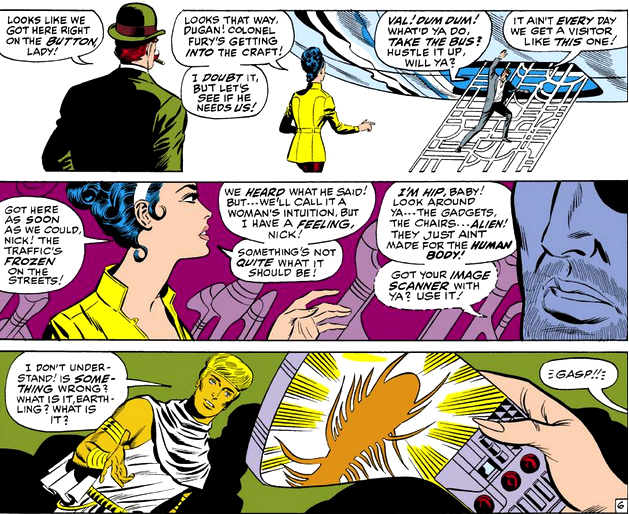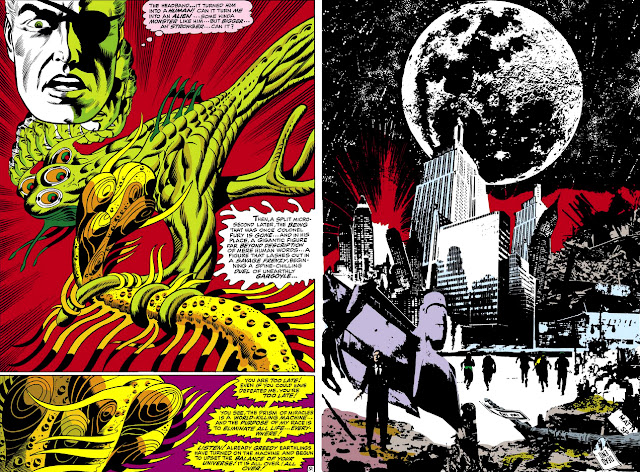For its final issue in May of 1968, you can't say that Strange Tales didn't try to go out with a bang--the kind of bang, unfortunately, which portends the end of the world, as artist/writer Jim Steranko makes clear on the splash page of the Nick Fury portion of the issue.
Steranko and inker Joe Sinnott's impressive opening page, which entreats the reader to turn it and find out the details, receives a bit of reworking for its appearance in the letters page* of the new Nick Fury, Agent of SHIELD series which premiered the following month. Steranko's original depiction, come to think of it, would have made a fitting entry in the PPC's prior post featuring the art of the letterer, though it's difficult to tell whether it was Steranko or letterer Sam Rosen who superimposed the mushroom cloud effect with the story's title. (Perhaps both men pooled their talents.)
*Entitled--what else?--"Don't Yield, Write S.H.I.E.L.D."
This final Fury story of the book--one that I've been meaning to get back to ever since it was featured as part of a brief roundup of splash pages which caught my eye--turns out to be a bit offbeat for a SHIELD story and perhaps not a tale that one would expect to find as part of a mag's final issue, yet it comes off as well-timed for regular readers since it provides a change of pace from the heated Yellow Claw conflict which had played out over several issues. As to what's on Fury's mind here, the head of SHIELD isn't actually brooding about some approaching apocalypse, but is instead dictating a message to Jimmy Woo, a former FBI agent who got his start in the 1956-57 espionage series Yellow Claw and then segued to Strange Tales in the fall of '67 where he lent a hand to SHIELD against the Claw--a partnership which Fury is interested in formalizing.
Of course, when it comes to SHIELD, duty may call at the drop of a hat, something Fury knows all too well--but the coming threat will in the end be unlike any other that he's faced.
(In the cross-section of New Yorkers which Steranko presents here, how interesting it is to see him make the point that not everyone is an Avengers fan. While painting them as "delinquents" may sound like he has an axe to grind with them, it's possible this gentleman may be miffed because Captain America is no longer part of their active roster; indeed, at this point in time, their new lineup arguably offers little in terms of either familiarity or reliability for the general public.)
Back at headquarters, Steranko prepares to deal in Fury's comrades to the developing situation in the city--his old wartime buddy, Dum Dum Dugan, and Contessa Valentina Allegra de la Fontaine, who joined the agency as a way to follow in the footsteps of her parents who were killed aiding the Italian resistance. As Dugan notes, the Countess has become a SHIELD agent who doesn't necessarily fit the mold of a run-of-the-mill spy.
As for this story's "threat," our visitor from another dimension appears to be anything but, as Dugan's first impression would have us believe--in fact, with what he's offering the human race, he almost seems to be too good to be true. But Fury is more cautious--and once inside the alien vessel, his observations bear out what Val's scans would subsequently reveal of the "golden man" named Vaengr.
His deception revealed, Vaengr, in a matter of moments, becomes Fury's worst nightmare, and that of the entire world, as well--with Fury paying a price both personally and physically inside the ship, while, outside, Vaengr's "prism of miracles" activates to initiate its true function. It's no doubt a scenario made to order for a book like Strange Tales, which originally specialized in stories that veered toward the macabre with little to no warning--but for Fury, SHIELD, and the Earth, these are the last moments of life which, to Vaengr and his race, only amount to a link in a chain of universal death that will envelop other havens of life in whatever cosmos they may be found.
Yet it's this story's final page which comes almost full circle with Strange Tales as it was originally conceived, while establishing symmetry with the first part of Page One--only this time, the only alert Fury receives comes from Dugan and not the Contessa, which triggers in Fury a chilling sense of déjà vu.
There are one or two question marks which the reader might raise when reading this story page by page. For one thing, to see Fury react in much the same way as one of the hapless characters from the mag's days in the late '50s, who inevitably faced a truth which shook them to the core, is asking a lot of those of us who can't possibly see gruff, hard-as-nails Nick Fury in their company, in spite of Dugan's attempt to sell us on Fury's out-of-character unnerved reaction upon waking. Also, just after Val's scan of Vaengr takes place, there's an abrupt interim scene featuring Jimmy Woo receiving and listening to Fury's pitch concerning his joining SHIELD--a strange thing for someone caught in a nightmare to shift his focus to. For what it's worth, nothing comes of the UFO report--which leaves Fury free to return to form the following month, and in a series all his own.











Must have been brutal to flog a SHIELD comic back in the day. They were awash in negative press.
ReplyDeleteThey were always the "second-rate" organization in ALL the Marvel titles. "SHIELD can't stop (name menace)! Call the Avengers! Get the F.F. on the phone!" Or, in a more clandestine story line, Spider-Man or Daredevil witness SHIELD get clobbered and step in to save the day.
And every so often, they were second-rate and> the actual antagonists. The Mandroids come to mind. Many missions attacking the Hulk. (Has any Marvel hero never been the target of a SHIELD mission?) They messed with my favourite hero's business and got slapped silly for their trouble.
So, when a kid is spinning the rack looking for something to read, the adventures of the government loser agency needs a hard sales pitch.
(That Steranko art adds a lot of oomph to that sales pitch...)
Marvelous Art, outta this world!
ReplyDeleteOn the other hand, Murray, SHIELD must have had something on the ball if Captain America was so adamant about getting in touch with Fury and joining the agency--nor was Tony Stark about to turn down being appointed Director of the organization when Fury was removed from the post (and subsequently went into hiding) and Maria Hill stepped down. And frankly, the government would be crazy to reach for the phone and call in a "second-rate organization" to go in and try to corral the Avengers, wouldn't they?
ReplyDeleteIMO it made good sense for Marvel to keep costumed heroes and SHIELD at arm's length from each other--mostly to avoid questions like "Why isn't ____ handling this instead of ____?", but also to distinguish an espionage/special ops agency from the Avengers, the FF, et al. who go into action for entirely different reasons (something Director Stark didn't care much for when he aligned himself with the intent of the SHRA). For the two to constantly clash and question each other's approach in a crisis where both show up to save the day (which has happened occasionally--say, for instance, the Avengers/Defenders War climax, where it was decided that Fury and his forces should concentrate their efforts on Earth) would probably get old fast. On the other side of that coin, however, I think that Fury is savvy enough to realize that costumed super-beings are good assets to have around when they're needed.
I think we're doing, what do they call it, the Watsonian and Doylesite tango here.
ReplyDeleteIn-universe, obviously SHIELD is a premiere organization of super-spies, filling a vital need in a world of crazy critters and diabolical megalomaniacs.
I'm speaking out-of-universe, where I pick up a comic of my favourite superhero and there's SHIELD, quite often, getting in my hero's way. Most of the time it was only that gruff savvy from Fury that allowed the heroes to get on with business.
So, my point is that I would have needed an extra-strong sales pitch to pick up a title featuring SHIELD. (I was too young at the time of the featured issue to appreciate international espionage)
The last issues of Strange Tales featured Gene Colan and Tom Palmer on Dr Strange along with Steranko's SHIELD. So for me, a quick look inside the comic would have been all the sales pitch I needed.
ReplyDeleteAs it happens, I originally read those SHIELD stories as a kid when they were reprinted as a back-up - along with the Roy Thomas/John Buscema era FF - in Marvel UK's mid-late 70s Captain Brexit weekly.
Even though I didn't much care for the lead feature (this was well before Alans Moore & Davis) I got the mag regularly, as Steranko hooked me in straight away. Even now, over four decades later, I vividly recall the impact of seeing the SHIELD aerial assault on the Yellow Claw's Sky Dragon for the first time.
-sean